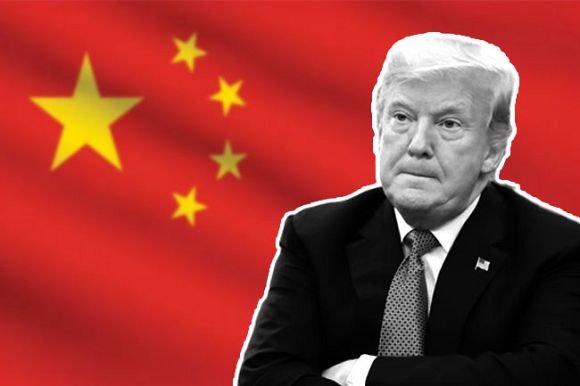The biggest casualty in Trump's tariff trade war is the American economy and the nation's consumers, writes Patrick Drennan.
ON 2 APRIL, U.S. President Donald Trump announced tariffs on about 90 of America’s trading partners. The rate of each of the tariffs was based on a crude and incredulous formula (the trade deficit in goods, divided by 25%).
On 9 April, Trump, under intense political pressure, decided on a 90-day pause to the tariffs on all countries barring China. Then, on 12 April, he exempted some cell phones, chips and computers.
America-centric nationalists believe that tariffs will protect American industry and somehow reintroduce large manufacturing back to America. They ignore the fact that other countries will simply divert their trade away from a volatile American market.
Five examples
China
China used to buy most of its soybeans from American farmers. The first Trump Administration placed tariffs on China and it responded with tariffs on other products, including soybeans. China simply bought more product from Brazil and lately from Argentina. The counter-tariffs of a further 115% rate on soybeans in response to the latest American tariffs will intensify the Chinese movement towards South America.
Colombia
A 10% base tariff on Colombian exports did not greatly affect Colombia, although Americans will now pay more for coffee, cut flowers and diamonds. However, Colombia is now considering joining China’s Belt and Road Initiative and the BRICS financial system.
Furthermore, Colombia just decided to purchase Saab JAS-39 Gripen jet fighters over America’s Lockheed Martin F-16 fighter jets. This is not only the billion-dollar profit forgone, but also the estimated annual $10 million per aircraft maintenance fee that would have gone to Lockheed’s subsidiary company, Leidos.
Germany
The German drive to reach greenhouse gas neutrality by 2045 explains part of its trade relationship with the United States. Germany imports less American oil as overall oil consumption there has been decreasing since 1997. A policy that is not particularly aimed at America. Germany imports fewer cars from America because American cars are gas-heavy and oil in Germany, and the rest of Europe, is expensive.
BMW, Volkswagen and Agi already have large car factories in the United States, but they are facing worldwide competition from electric cars and hybrids. Consequently, profits are down and all have had periods of downsizing. Tariffs may exacerbate that trend.
An aside is that the Trump Administration has initially avoided placing tariffs on German pharmaceutical companies. America is the world’s largest importer of pharmaceuticals, including the highly advanced German drugs and medicines from BioNTech, Bayer and Boehringer Ingelheim.
Nevertheless, on 8 April, Trump hinted that he would announce a tariff on some pharmaceuticals. This is still unlikely to affect German companies that have intellectual property on certain drugs, but aimed at generic drug makers in India and China.
Australia and New Zealand
Australia imports 13% of its oil from America, 34% from Malaysia and 15% from Brunei. Australian companies will seek less troublesome Asian markets for future contracts. The Australian Government recently rebuffed a trade deal with China and is now seeking a free-trade agreement with the European Union.
Some New Zealand exporters are already quitting the American market.
One Kiwi exporter declared:
“We have a number of deals [with America] in the pipeline that the customer wanted DDP (Deliver Duty Paid) but we have revised these to be CIF (Cost, Insurance, Freight) so they are responsible for all tariffs. Hopefully, it won’t stop them completing the deals.”
South Korea
South Korean companies Samsung, LG and Hyundai had planned to build factories in the United States based on the CHIPS and Science Act subsidies introduced under the Biden Administration. Trump wants the subsidies to end, arguing that tariffs would be more effective. This could endanger contracts already signed. A 25% tariff on these South Korean companies will not encourage them to build in America if the profit margins are insecure.
There are already discussions between the Japanese, Chinese and South Koreans about joining together on trade, something that was previously inconceivable. A trilateral trade agreement will benefit China, to the detriment of the United States.
Regardless of how overseas markets deal with these tariffs, whether they retaliate (China, Canada and the European Union), negotiate (Vietnam, Taiwan and Japan), or ignore them (India, Indonesia and New Zealand), most experts agree that in the short-term it will result in increased inflation and unemployment for Americans. In the long term, overseas companies will not enter good-faith contracts with American companies if the terms can be overturned by political whim.
Patrick Drennan is a journalist based in New Zealand, with a degree in American history and economics.
 This work is licensed under a Creative Commons Attribution-NonCommercial-NoDerivs 3.0 Australia License
This work is licensed under a Creative Commons Attribution-NonCommercial-NoDerivs 3.0 Australia License
Support independent journalism Subscribe to IA.

Related Articles
- Lunatics have taken over U.S. Government asylum
- Beautiful? Or just plain tariff-ic
- Trump’s tariff pause a high-stakes gamble with the world
- What Trump's oil tariff threats mean for Australia
- Donald Trump is the world’s most audacious liar













